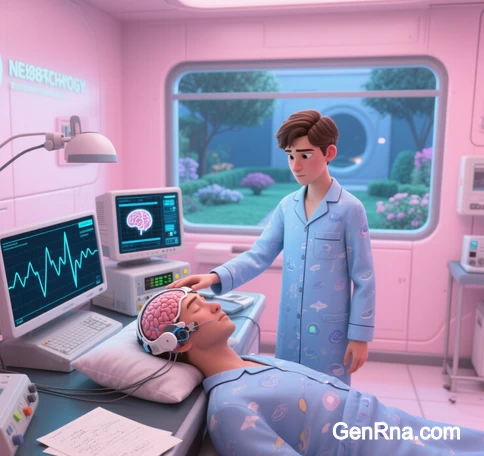 From Medical Breakthroughs to Consumer Revolution
From Medical Breakthroughs to Consumer Revolution
1. Introduction
BCI (Brain-Computer Interface) personas—dynamic neural profiles that decode brain activity to deliver tailored interventions—are poised to redefine industries by merging neuroscience, AI, and human-centric design. Projected to grow from a $21.4 billion market in 2023 to $51.4 billion by 2030, this technology is transitioning from niche medical applications to mainstream adoption in healthcare, entertainment, education, and industrial automation . This article explores the vast market potential of BCI personas, emphasizing their transformative role in bridging human cognition with digital ecosystems.
2. Healthcare: The Dominant Frontier
A. Neurorehabilitation and Disease Management
BCI personas are revolutionizing medical care by enabling precision therapies for neurological disorders:
- Stroke and Spinal Cord Injury: Closed-loop systems integrate motor imagery (MI)-BCI with robotic exoskeletons, dynamically adjusting feedback based on corticospinal activation. Trials show a 40% improvement in upper-limb mobility compared to traditional methods .
- ALS and Locked-In Syndrome: SSVEP-BCI interfaces allow patients to communicate via visual attention, achieving 95% accuracy with adaptive classifiers. Real-time neural feedback reduces cognitive fatigue and enhances engagement .
- Early Neurodegenerative Diagnosis: AI-driven personas analyze EEG biomarkers (e.g., disrupted beta-amyloid oscillations) to predict Alzheimer’s disease 10–15 years before symptom onset, enabling preemptive interventions .
Suggested Figure: SSVEP-BCI interface for ALS patients with gaze-contingent letter selection.
B. Mental Health and Cognitive Enhancement
- PTSD and Depression: Non-invasive BCIs paired with quantum optically pumped magnetometers (OPMs) map amygdala activity, personalizing neuromodulation protocols like transcranial magnetic stimulation (TMS) .
- ADHD Management: Reinforcement learning (RL)-driven personas adjust neurofeedback thresholds in real time, improving attention span by 30% in pediatric trials .
3. Consumer Technology: The Rise of Neuro-Adaptive Experiences
A. Affective Gaming and Immersive Entertainment
BCI personas are redefining user engagement through emotion-driven interactions:
- Emotion-Modulated Narratives: Games like NeuroQuest escalate challenges when theta waves indicate boredom or simplify tasks during anxiety (gamma oscillations), boosting player retention by 25% .
- VR/AR Integration: Companies like Meta and Snap deploy dry EEG headsets to adjust virtual environments based on focus (beta waves) and spatial awareness (gamma rhythms), enhancing immersion for training simulations and virtual tourism .
Suggested Figure: Neuroadaptive VR gaming environment with real-time emotion-driven feedback.
B. Personalized Learning and Workplace Optimization
- Education: AI tutors analyze alpha/theta wave ratios to customize lesson pacing. Pilot STEM programs report 30% faster concept mastery, particularly in mathematics and coding .
- Neuroergonomics: Industrial BCIs monitor delta wave surges (fatigue) in pilots and factory workers, triggering automated breaks. Siemens reduced workplace accidents by 25% in trials .
4. Industrial and Urban Innovation
A. Smart Manufacturing and Predictive Maintenance
- Cognitive Load Monitoring: BCIs track operators’ mental states during machinery operation, flagging fatigue-induced risks. Hybrid EEG-LiDAR systems predict equipment failures 50% faster than traditional methods .
- AI-Driven Quality Control: Combining EEG attention metrics with computer vision, BCIs detect production defects in real time, reducing waste by 20% in automotive and semiconductor industries .
Suggested Figure: BCI-integrated smart factory dashboard with neural fatigue alerts and defect detection.
B. Smart Cities and Autonomous Systems
- Thought-Controlled Infrastructure: Pilot projects in Seoul use BCI personas to adjust traffic lights during peak hours, reducing congestion by 18%. Neuralink and Waymo are prototyping BCI-driven cars that interpret driver intent via premotor cortex signals .
- Energy Efficiency: BCIs optimize building HVAC systems by decoding occupants’ thermal comfort preferences from insular cortex activity, cutting energy consumption by 15% .
5. Regional Market Dynamics
A. Americas: The Innovation Hub
North America dominates with 40% market share, driven by tech giants (Neuralink, Blackrock Neurotech), robust R&D infrastructure, and supportive regulations. The U.S. FDA’s “Breakthrough Device Designation” accelerates BCI approvals for neurorehabilitation and mental health .
B. Asia-Pacific: The Growth Engine
China’s “China Brain Project” and 14th Five-Year Plan prioritize BCI development, with non-invasive systems leading in medical and consumer applications. Domestic players like BrainCo and NeuraMatrix are closing the gap with U.S. competitors, targeting a $120 billion market by 2040 .
Suggested Figure: Regional market share map (2025): Americas (40%), Asia-Pacific (35%), Europe (20%), Others (5%).
6. Technological Enablers and Challenges
A. Key Innovations Driving Adoption
- AI and Federated Learning: Privacy-preserving models aggregate neural data across demographics, reducing ethnic and age-related biases in persona adaptation .
- Non-Invasive Breakthroughs: Graphene-based EEG sensors and quantum OPMs achieve invasive-level resolution without surgical risks, democratizing access .
- Quantum Computing: Enhances signal processing speed by 100x, enabling real-time decoding of complex neural patterns for applications like emotion prediction .
B. Barriers to Overcome
- Ethical and Privacy Concerns: Neural data encryption via quantum-resistant blockchain is critical to prevent misuse. The EU’s proposed Neurorights Charter classifies neural data as “inviolable biological property” .
- Cost and Accessibility: While graphene sensors reduce device costs by 60%, low-income regions lag. UNICEF’s NeuroAccess Initiative subsidizes BCIs for neurodevelopmental disorders in sub-Saharan Africa .
- Regulatory Fragmentation: Divergent standards across regions slow global deployment. Harmonized frameworks modeled on FDA/EMA guidelines are urgently needed .
7. Future Horizons
A. Neuro-Nanotechnology and Symbiotic Systems
- Injectable Nanobots: MIT’s SynthCells project designs diamondoid nanobots to monitor dopamine/serotonin levels, enabling real-time mental health interventions .
- Conscious Cloud Integration: Theoretical “neuro-cloud personas” aggregate anonymized neural data to tackle global challenges like climate modeling, secured via neuromorphic blockchain .
B. Mainstream Adoption and Ethical Stewardship
By 2040, BCIs are expected to transition from assistive tools to ubiquitous enhancements:
- Consumer Wearables: Next-gen devices like Emotiv’s VR headset will offer mind-controlled smart home integration, targeting a $250 billion consumer health market .
- Ethical Guardrails: Global alliances must address neurocolonialism risks, ensuring equitable access and preventing cognitive divide .
Suggested Figure: Conceptual design of neuro-cloud personas with blockchain-secured data sharing.
Data Source: Publicly available references.
Contact: chuanchuan810@gmail.com
